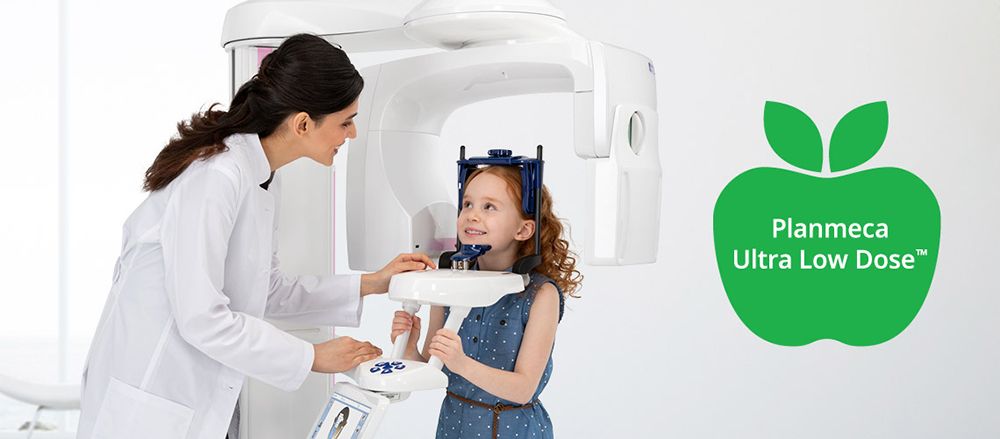New Studies Indicate Planmeca Ultra Low Dose Technology Scientifically Proven
The Planmeca Ultra Low Dose™ protocol has been studied in several studies, one of which concluded that the technology reduces patient doses by up to 77% with no statistical reduction in image quality between the standard and ULD protocols.

CBCT imaging delivers vast amounts of data to help clinicians with dental implants, orthodontics, endodontics and more, but with its use may come concerns about high levels of radiation. A number of studies have shown that the Planmeca Ultra Low Dose™ solution reduces these concerns by delivering quality imaging with a reduction of radiation exposure.
The Oral Surgery, Oral Medicine, Oral Pathology and Oral Radiology journal recently published a study that concluded that "the overall image quality was at a diagnostically acceptable level for the defined diagnostic task [using the Planmeca Ultra Low Dose™ (ULD) protocol]." Additionally, the study remarked that applying [Planmeca AINO™] noise reduction filter had a "positive effect on image quality when the exposure dose is low," a typical byproduct when reducing radiation.
Similarly, other studies previously concluded e.g. that:
- Planmeca Ultra Low Dose is recommended for pre-implant radiographic assessment
- Cephalometric images reconstructed from Planmeca Ultra Low Dose CBCT images should be considered in orthodontic treatment planning
- Planmeca Ultra Low Dose images have sufficient diagnostic image quality to be used in a pediatric setting for planning and follow-up imaging
Planmeca's success in lowering patient dose is important not only because it reduces risk to the patient, but also because it allows clinicians to employ CBCT technology in a wider variety of applications. And, while research is conducted to study and validate the effects of technological advancements, the real winners of this scientifically proven technology are the patients. Dental professionals that employ Planmeca Ultra Low Dose imaging are acquiring CBCT scans that are diagnostically acceptable for the task while significantly reducing patient exposure.
Many Planmeca customers have discovered that radiation levels using ULD are often less than that of traditional 2D radiology while the ULD images provide plenty of data to support efficient and accurate diagnoses and predictable treatment outcomes–another patient benefit.
Peter Green, DMD, a board-certified dental radiologist, has experience reviewing CBCT scans at all resolutions and voxel sizes. According to Dr Green, image quality is extremely important when it comes to diagnostic value and making a proper evaluation.
“I see the best and the worst DICOM files come across my desk. Planmeca CBCT systems consistently produce high quality images, and as a radiologist, it is reassuring when I see scans utilizing Planmeca Ultra Low Dose. Not only do I have a diagnostically viable image, I also know the patient has not been exposed to unnecessarily high doses of radiation," he says.
Dr Green also prefers reviewing 3D images over 2D. Two-dimensional studies have been the cornerstone of dental imaging since its inception, he says, but the diagnostic value of 2D is limited.
“When we review a 2D image, we uncover distortion of anatomy because of angulation and magnification errors. We also see overlapping anatomy which is inevitable with 2D imaging. These kind of inherent inaccuracies often hide small apical lesions, such as those confined between the cortical plates. With 2D, you are in fact only seeing part of the picture,” he explains.
CBCT allows viewing from any perspective and with no distortion. With Planmeca Ultra Low Dose technology, providers no longer have to sacrifice excellent image quality to achieve a significant reduction in dose, according to Dr Green. This makes it possible to enjoy the benefit of 3D information for the dose of a panoramic or even a set of bitewings.
"We continue to strive to help doctors be better at their job while focusing on patient safety,” says Brent Garvin, senior product manager for imaging in North America at Planmeca USA. “This is our sixth major study validating the effects of ULD on our industry."
Another exclusive feature aimed at increasing patient safety is the Planmeca CALM® movement correction algorithm. “We have drastically reduced the risk of having to redo a 3D scan because the patient shifted their weight during acquisition or swallowed. This feature recognizes patient movement and automatically makes the correction resulting in a diagnostically valuable image," Garvin explains. "It doesn't get any easier than this."
The implications of ultra low dose patient radiation paired with diagnostically valuable image quality is paving the way for CBCT use in routine diagnostics validating the Planmeca slogan – Better care through innovation, the manufacturer states.
ACTIVA BioACTIVE Bulk Flow Marks Pulpdent’s First Major Product Release in 4 Years
December 12th 2024Next-generation bulk-fill dental restorative raises the standard of care for bulk-fill procedures by providing natural remineralization support, while also overcoming current bulk-fill limitations.